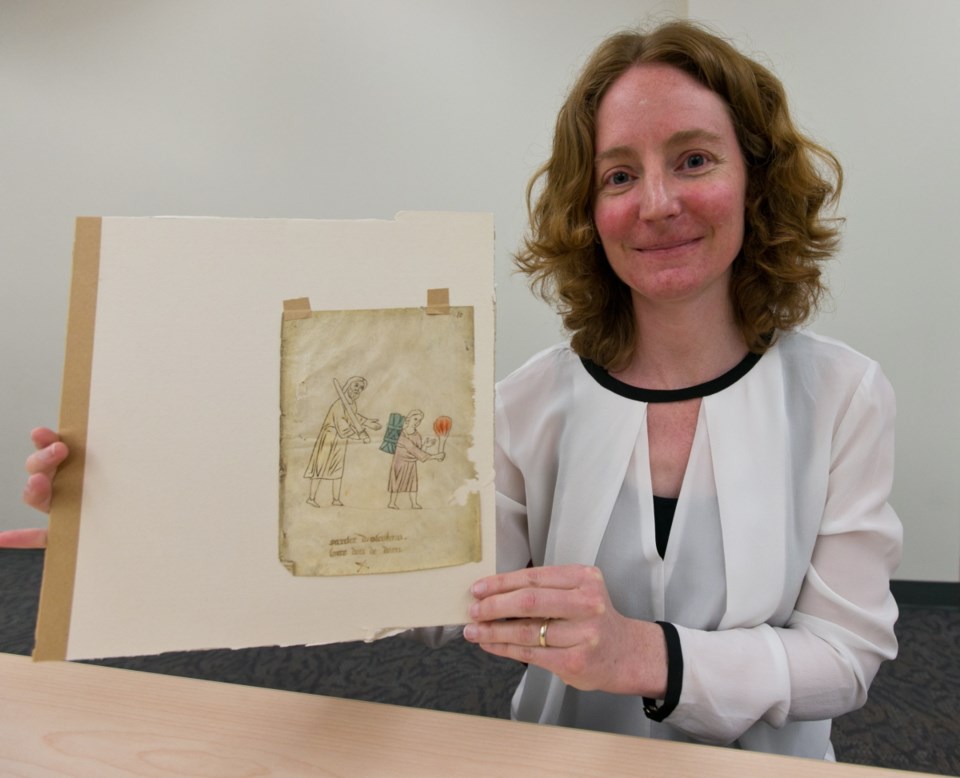An Internet-savvy historian has unlocked secrets of an 800-year-old religious image stored in the basement of the University of Victoria library.
The small picture, depicting Abraham preparing to sacrifice his son, Isaac, was donated in 2010 by a Victoria woman who had inherited it. The picture is drawn on goat or calfskin parchment and was first assessed as originating from the 1500s. Initially, little else could be speculated other than it was probably a fragment from a book or Bible.
Heather Dean, associate director of UVic’s special collections library, said that, when it arrived, the artifact sparked the interest of Erik Kwakkel. At the time, the Dutch historian was an assistant history professor at the university. He taught a course in the history of the book, but was also a keen student of the Internet. “He has a very active social media presence,” Dean said. “He blogs a lot and uses Twitter a fair bit.”
In 2010, Kwakkel returned to the University of Leiden in the Netherlands and the fragment was returned to special collections in the basement of the MacPherson Library.
But in December, Kwakkel was online looking at a French database of 13th-century medieval manuscripts.
Suddenly, he spotted an image very similar to the UVic fragment. “There was no need to think ‘Where did I see this before?’ ” Kwakkel wrote in an email to the Times Colonist. “This was the same image as seen in the UVic fragment.”
“Such ‘zap’ moments [as I call them] happen from time to time,” he said. “But few are as satisfactory as this one because the resemblance of the two paintings is so evident.”
UVic’s fragment is now believed to have been produced in conjunction with two pictorial Bibles — one in Amiens, France, and the other in Harburg, Germany. Produced in Pamplona, Spain, they are known as the Pamplona Bibles.
They were created by professional artists and scribes, commissioned by King Sanchez of Navarre, Spain, about 1200 — 300 years earlier than the initial assessments of the UVic fragment.
Looking at the Pamplona Bibles, the UVic fragment can be seen as the second image in a three-picture story.
The first picture illustrates God telling Abraham to sacrifice Isaac. The second, as in UVic’s, shows the two heading out to obey the order. The third shows the Angel of God coming in to stop Abraham at the last moment.
Dean said such stories and pictures would be a special hint to a Spanish king around 1200, a time of political tension and conflict. At that time, the country had a strong Islamic presence from nearby North Africa. So, Bible stories such as Abraham and Isaac would have been powerful reminders to stick with the Christian faith.
Dean also noted a certain irony: When Kwakkel was looking at the French database online, a printed copy of the French manuscript was sitting in the main stacks of the UVic library. Nobody had connected the two.
Dean said Kwakkel’s discovery is especially satisfying for her, showing that good scholarship can be achieved with UVic’s collection, even though it’s small compared with those at universities in the eastern U.S. and Europe.
“Our collection is still meaningful because discoveries can still be made,” Dean said.
“There are exciting connections to be made and there is real work that can be done, even though it’s a small collection.”



